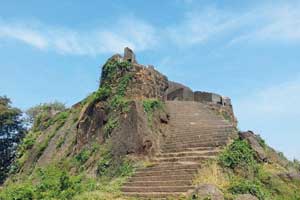This is how it acquired the name 'Shinva' or 'Sheev' (Marathi: boundary)


Sion Fort
ADVERTISEMENT
Hard as it may be to imagine, Sion was a wasteland of saltpans in the 17th century. It was right at the northern end of Bombay island, the last frontier before the waters separated it from Salsette. This is how it acquired the name ‘Shinva’ or ‘Sheev’ (Marathi: boundary). Now, the folks at Sahapedia Walks and Talks want to take you back in time to retrace its historic relevance. One of their guides, Ashwini Nawathe, will take participants through its 17th-century landmarks that are still around, including the Sion fort, Duncan Causeway, Rewa fort and St Thomas’s Church. “Many Mumbaikars cross Sion during their daily commute. But they don’t get a chance to appreciate the neighbourhood, in the context its history”, says Nawathe.

Ashwini Nawathe with a group
Legend has it that in 1534, the Portuguese took over Sion after the then ruler, Qutb-ud-Din Bahadur Shah of the Gujarat Sultanate, was killed on board a ship while making an agreement with them. The land was then given to Portuguese priests to build a chapel, who named it after Mount Zion in Jerusalem. Another theory is that the British named it Sion, which in Hebrew means ‘highest point’, apt for a hilly region with several lookout points.
ON May 27, 8 am
starting point Ticket counter, Sion railway station.
CALL 9769583237
EMAIL walks@sahapedia.org
LOG ON TO facebook.com/Sahawalks
Catch up on all the latest Crime, National, International and Hatke news here. Also download the new mid-day Android and iOS apps to get latest updates
 Subscribe today by clicking the link and stay updated with the latest news!" Click here!
Subscribe today by clicking the link and stay updated with the latest news!" Click here!






